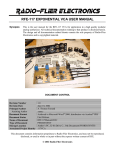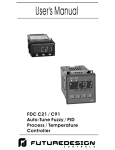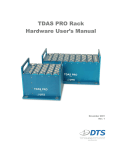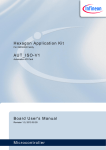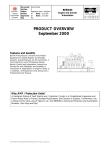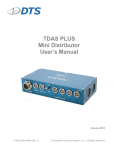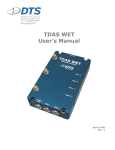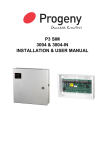Download TDAS PRO LAB User Manual - Diversified Technical Systems
Transcript
TDAS PRO LAB Hardware User’s Manual May 2011 Rev. 2 Table of Contents Technical Overview ........................................................................................2 TDAS PRO LAB Rack Systems .....................................................................4 Basic Care and Handling................................................................................5 Unpacking the System ....................................................................................6 Connecting the Cables....................................................................................6 Connecting Communication and Trigger Cables ...................................................... 6 Switching On Power...................................................................................................... 7 Sensor Connector Options..............................................................................8 Wiring Sensor Cables ......................................................................................8 Calibration Techniques ..................................................................................9 Voltage Insertion............................................................................................................ 9 Shunt Calibration............................................................................................................ 9 General Care ................................................................................................. 10 TDAS Hardware Calibration ........................................................................ 10 Specifications ................................................................................................ 12 Calibration ..................................................................................................................... 13 Analog-to-Digital Conversion .................................................................................... 13 Triggering Systems ....................................................................................................... 13 Sensor ID ...................................................................................................................... 13 Power Requirements and Features ............................................................................ 14 Environmental .............................................................................................................. 14 Physical .......................................................................................................................... 14 Control Software .......................................................................................................... 14 i C H A P T E R 1 — I N T R O D U C I N G T H E T D A S P R O 1 L A B Chapter Introducing the TDAS PRO LAB Each TDAS PRO LAB module is a highly advanced data recorder that is also easy to use. C ongratulations on choosing a TDAS PRO LAB data recorder for your data collection project! We are proud of our product and we want you to be completely satisfied with your purchase. The TDAS PRO LAB is the latest evolution of our original TDAS product that has won praise for value and reliability. The following information will introduce you to the inner workings of the TDAS PRO LAB. Technical Overview Each 8-channel module functions as a complete, standalone data recorder with integral microprocessor, adaptive signal conditioning, excitation sources, A/D circuitry, and data memory. TDAS PRO LAB hardware is a standard 19-inch, rack-mounted system commonly used for stationary laboratory data collection. Each 8-channel module functions as a complete data recorder with integral microprocessor control, adaptive signal conditioning, excitation sources, A/D circuitry and data memory. TDAS PRO LAB functions are set-up using an IBM-compatible computer. Once the computer initializes the system, it can be disconnected and the module will collect data with no additional support. After the test, data stored in each module is downloaded to the PC hard drive in binary format. Once on the hard drive, the binary data files are then unpacked for viewing and post-processing. There are no potentiometers to adjust because hardware settings are performed completely under software control. Every time a data collection task is initiated, the software runs a thorough calibration check on each measurement channel. Appropriate gains are set, sensor offsets are zeroed and anti-aliasing filters are set. Sensor inputs are through connectors located on the front of each TDAS PRO LAB module. See Chapter 5−Configuration/Specifications for your specific connectors and pin assignments. 2 C H A P T E R 1 — I N T R O D U C I N G T H E TDA S BLO CK DI A GRA M T D A S L A B TDA S M O DULE PROCESSOR SIGNAL COND. MEMORY SERIAL LINK NOT REQUIRED DURING DATA COLLECTION SENSOR INPUTS A/D CONV. SERIAL LINK SERIAL LINK P R O TRIGGER N O TEBO O K O R DESKTO P WINDOWS GUI SOFTWARE TEST SETUP DATA COLLECTION TEST SETUP FILE (.TSF) MODULE 1 RATE &TIME SENSOR CHANS .SIF .SIF .SIF MODULE 16 RATE &TIME SENSOR CHANS SENSOR INFORMATION FILE - DESCRIPTION - CAL FACTOR - GAIN FACTOR - MODEL - SERIAL NO. CHOOSE .TSF VERIFY SETUP WAIT FOR TRIGGER COLLECT DATA DOWNLOAD DATA .SIF .SIF CALCULATED CHANNELS MULTIPLY, INTEGRAL, HIC, ETC. Figure 1: TDAS Block Diagram 3 POST PROCESS VIEW DATA SCALE DATA FILTER DATA PERFORM CALCULATIONS PLOT DATA TO SCREEN C H A P T E R 1 — I N T R O D U C I N G T H E T D A S P R O L A B Each TDAS PRO LAB module contains the following subassemblies: Each TDAS PRO LAB module is a completely autonomous data collection system. A System Board that contains eight channels of adaptive signal conditioning, voltage insertion calibration functions, filtering, A/D, and triggering circuitry. Hardware antialiasing filters are set under software control based on user-selected data sampling rates. A Processor Board that is very similar to most PCs in that it has a microprocessor, program storage, RAM, and communication links. The internal processor uses digital I/O channels to control all module functions. An Auxiliary Board that contains power control circuitry, battery charging/status circuitry, software-programmable isolated excitation sources, and shunt calibration circuitry. Power inputs are diode protected and fused by self-resetting fuses. Each measurement channel consists of the elements depicted below. Chapter 5−Configuration/Specifications for additional information.) Front-end gain 1 or 32 voltage insertion Sensor shunt cals Instrument A mp (See Set gain stages 1 and 2 Gain1 0 - 8.0 Gain 2 0 - 8.0 8-pole & 5-pole Butterworth Filters t/ h amp A / D Input • Enable Sample and Hold Front-End Signal Switching • Bypass O ffset DA Cs 12-bit Coarse 12-bit Fine TDAS PRO LAB Rack Systems Up to six 8-channel modules can be installed in the available 19” rack. Several racks may be daisy-chained to form systems with large channel counts. The rack unit distributes communication signals, operating power, power-up control, trigger signal, and slot programming codes. The rack also contains a 1000 V, isolated, time zero trigger buffer, power status indicator and provisions for using RS232 communication protocols. Note that Ethernet (10Base-T) communications are optional. This requires additional hardware installed at the factory and therefore must be specified at the time your order is placed. Please see your packing slip for the communication cable(s) supplied with your system to determine what communication options you have. 4 C H A P T E R 1 — I N T R O D U C I N G T H E T D A S P R O L A B Basic Care and Handling The TDAS PRO LAB is a high-precision measurement instrument designed to operate in a laboratory-testing environment. This system was not designed to tolerate shock, vibration, spilled liquids, etc. WARNING: TDAS PRO LAB is not a crashworthy system. Do not subject the system to any adverse shock loads or extreme environmental conditions. When transporting the unit, treat it as you might a laptop computer and you should have no problems. . 5 C H A P T E R 2 — G E T T I N G 2 S T A R T E D Chapter Getting Started Getting started with the TDAS PRO LAB is easy. Follow these simple steps and you will be collecting data before you know it! T his section will assist you in using your TDAS PRO LAB system for the first time. After unpacking the system, you will attach an external power supply, connect the communication cable, and perform a preliminary system test. Unpacking the System Open the box and unpack the system. Please check for the items specified on the packing list for your system. If you are missing any items, please contact us immediately so that we may correct any shortages. Connecting the Cables Plug the AC power cord into any power outlet that supplies 100-240 V, 50-60 Hz. The ground pin on the plug must connect to a suitable facility ground. Connecting Communication and Trigger Cables TDAS PRO LAB contains a robust RS232C serial communication driver and may be connected to the standard serial port on virtually any IBM-compatible personal computer. You can use any available communications port from COM1 to COM4. 1. Attach one end of the serial cable to the TDAS PRO LAB rack connector (see Figure 2). 2. Attach the other end of the serial cable to the communications port on your computer. 6 C H A P T E R 2 — G E T T I N G S T A R T E D Ethernet O i Serial Connection Trigger Input Figure 2: TDAS PRO LAB Rear View (RS2332 and Ethernet option) • A standard, off-the-shelf, serial (RS232) cable is needed to communicate with the TDAS PRO LAB rack system. Note that the cable should not be any longer than 25 feet. Ethernet communications are optional and use either 19-pin LEMO connector. RS232 communications are also possible through either LEMO connector. Please see your packing slip for the communication cable(s) supplied with your system to determine what communication options you have. • A contact-closure trigger switch can be connected to the binding-post banana jack input located on the rear panel. • Please contact DTS if you have questions regarding these functions. Switching On Power The power switch for the TDAS PRO LAB is located on the second panel from the left and next to the power indicator LED. To switch the power on, toggle the switch to the up position. The POWER indicator LEDs on the module(s) and the rack will begin to blink green. When power is turned off, the POWER indicator on each module will stop flashing. If you turn off the power, then decided to turn it back on, you must wait at least 10 seconds after the module POWER indicators stop flashing to ensure a proper reinitialization of the modules. 7 C H A P T E R 3 — A T T A C H I N G S E N S O R S Attaching Sensors 3 Chapter The TDAS PRO LAB system supports a wide variety of common sensors. T he TDAS PRO LAB hardware works in concert with the software in such a way that one need only wire a sensor to the input connector and enter some basic sensor calibration information into a Sensor Information File (.SIF). Sensor Connector Options Each module can record up to eight channels of data simultaneously. There are a variety of sensor input connector and pin assignment options available for your TDAS PRO LAB module. Several options are available. Please see the documentation provided with your system to determine your pin assignments. Wiring Sensor Cables A wide variety of four-wire, bridge-type transducers are accommodated by the adaptive electronics within the TDAS PRO LAB. The system automatically accommodates bridge transducers with varying offsets and unequal arms. The auto-zero circuit is capable of balancing most bridges beyond their full-scale ranges. Half-bridge, three-wire sensors (such as potentiometers) can be accommodated by connecting the sensor excitation leads to +/- excitation, and the signal lead to - signal. Use “half-bridge” in the software set-up. Single-ended voltage inputs that are referenced to common may be accommodated by connecting the voltage source common to TDAS PRO LAB common and –sig, and the signal to the +Sig input. When 5 V excitation is chosen, the negative excitation terminal is internally connected to system common and may be used to reference single-ended input signals. 8 C H A P T E R 3 — A T T A C H I N G S E N S O R S Calibration Techniques TDAS PRO LAB hardware supports both voltage insertion and true shunt calibration methodologies. Voltage Insertion As the name implies, a precise calibration voltage source is temporarily connected to the sensor input amplifier. Voltage insertion calibrations are generally the best choice when the signal source has an actively driven output as is the case with many of the latest 0-5 V active output accelerometers and angular rate sensors. Voltage insertion may also be the best choice for passive sensors that have a bridge resistance that varies significantly with temperature, or from sensor to sensor. Some silicon-based, piezo-resistive sensors fall into this category. Shunt Calibration Shunt calibration is the temporary application of an external resistance across one leg of a bridge transducer. Shunt calibration is appropriate primarily for sensors that exhibit a predictable bridge resistance such as is the case with strain gage load cells, accelerometers, etc. The TDAS PRO LAB system allows you to apply shunt resistance from within the TDAS PRO LAB module and/or you can install an external shunt resistor between the -Sig and +Sig pins on the sensor interface connector. Please see Chapter 5− Configuration/Specifications for information regarding the internal shunt calibration resistors supplied with your system. 9 C H A P T E R 4 — M A I N T A I N I N G Y O U R S Y S T E M 4 Chapter Maintaining Your System The TDAS PRO LAB has no mechanical adjustments and will provide years of trouble-free service. F rom the ground up, TDAS PRO LAB data recorders have been developed to operate reliably in a laboratory testing environment. Each unit is handassembled by skilled technicians and there are no potentiometers to go out of adjustment. General Care The TDAS PRO LAB system does not require any special care or maintenance except for periodic calibration. Please remember though that all electronic instrumentation should be kept in a clean, dry environment and be treated gently. TDAS PRO LAB was not designed to withstand severe shocks (such as drops onto a hard floor), spilled liquids, or other environments that are commonly detrimental to electronic measurement equipment. TDAS Hardware Calibration TDAS PRO LAB modules are supplied fully-calibrated using NIST-traceable test equipment. Each TDAS PRO LAB module is delivered with an embedded Module Information File (MIF) that contains calibration values for excitation sources, internal references, diagnostic circuits, etc. DTS recommends a standard recalibration interval of six months in accordance with TDAS PRO LAB calibration protocols. DTS calibration tests include verification of all internal amplitude and time base references, frequency sweeps on each measurement channel and verification of the performance of excitation sources and ancillary circuitry. All TDAS products are delivered with updated MIF files and data plots showing the end-to-end response of each measurement channel against SAE J211 performance windows. 10 C H A P T E R 5 5 — C O N F I G U R A T I O N / S P E C I F I C A T I O N S Chapter Configuration/Specifications Our goal is that you understand our products well enough to trust us with your test data. I f you have questions regarding the performance of TDAS products that are not addressed in the specifications that follow, please contact DTS and ask to speak with a Technical Support. The following information identifies the configuration of your TDAS PRO LAB system. If you have any questions regarding the following configuration information or specifications, please contact us. 1. Our standard internal shunt resistors are 0.1%, 25 ppm with the following values: 1 2 3 4 5 6 7 10.0k 20.0k 40.2k 80.6k 162k 324k 649k Several options are available. Please see the documentation provided with your system to determine your specifications. 2. Our standard ½ bridge completion resistors are 1k at 0.1%, 25 ppm. 3. Each TDAS PRO LAB channel has a fixed 8-pole Butterworth filter and an adjustable 5-pole Butterworth filter. The fixed filter –3 dB point has been specified to optimize performance on sampling rates up to 20k samples/ sec/channel. (Standard is 4.3 kHz. Several options are available. Please see the documentation provided with your system to determine your specifications.) Software automatically chooses the best combination of fixed and variable filter usage for a selected sampling rate. 4. Although the sampling rate is software adjustable to fine increments, DTS purposely limits the choices. This allows DTS to perform 100% Quality Assurance checks at all sampling rates prior to shipment of your TDAS PRO LAB. Our standard sampling rates (per channel) are as follows: 250, 500, 1k, 2k, 5k, 8k, 10k, 12.5k, 20k, 25k, 38k, 40k, 50k, 60k, 75k, 100k, 150k, and 300k 11 C H A P T E R 5 — C O N F I G U R A T I O N / S P E C I F I C A T I O N S For convenience, a one-page summary of your system’s Hardware Configuration Specifications, including pin assignments, is included as a separate attachment. Specifications Analog Inputs Type: Common Mode Range: Protection: Impedance: Gain Range: Overall Bandwidth: Noise Spectral Density: Signal to Noise Ratio: Crosstalk: Accuracy: Auto Offset Method: Auto Offset Range: Auto Offset Accuracy: Bridge Completion: Anti-Alias Filters: Fixed Low Pass: Adjustable Low Pass: SAE J211: Differential, software programmed ±6.25 V ±50 V 50 MΩ typical 0.8 to 2000 D.C. to 25 kHz 0.06 µV/√¯Hz RTI Typical, 0-4,000 Hz 80 dB typical <0.05% under all circumstances 0.2% - automatically calibrated each use by internal 16-bit DAC Dual 12-bit DACs per channel Gain 0.8 to 31: ±5.0 V, Gain ≥32: ±150 mV Typically <0.1% of A/D full scale Software selected per channel Two per channel 8-pole Butterworth, customer specified knee point (4.3 kHz standard) 5-pole Butterworth, set under software control from 50 to 3,000 Hz System response meets SAE J211 requirements Digital Inputs Method: Propagation Delay: Excitation Method: Voltage levels: Accuracy: Rated Current: Short Circuit Recovery: Sensor inputs may be used as event inputs with filters bypassed 0.02 msec Individually galvanically/optically isolated and software selected Off, 5, 10 V standard; Off, 2, 10 V optional 0.25% basic, each channel calibrated and software compensated 50 mA per channel, individually current limited <1 msec in all modes 12 C H A P T E R 5 — C O N F I G U R A T I O N / S P E C I F I C A T I O N S Calibration Method: Voltage insertion Type: Accuracy: Shunt Calibration Number: Values: Switching Resistance: Individually software-controlled voltage insertion and multiple shunt calibrations 16-bit DAC Better than 0.1% 100 ppm/°C, NIST traceable and software compensated 7 internal and 1 external Customer specified, 0.1% 25 ppm <2 Ω Analog-to-Digital Conversion Method: Resolution: Maximum Sampling Rate: Minimum Sampling Rate: Relative Accuracy: Storage Technique: Memory Capacity/Type: Successive approximation with simultaneous sampling of all channels (up to 25k samples per second per channel) Standard 16-bit 304k samples/sec/module (38k on each of 8 channels, 100k on each of 3 channels, etc.) 1 sample/sec/channel ± 4 LSB (0.006%) Circular memory buffer. Any portion of the memory may be allocated to pre-trigger data. 2 options; 4 MB SRAM, 250k samples/ channel –or– 16 MB SRAM, 1 MB samples/ channel Triggering Systems Each Module: Rack System: Level Triggering: Conditioned contact closure input with T=0 received LED indicator Standard contact closure input, galvanically and optically isolated to 1 kV. 5-12 V optically coupled inputs available. Available from any channel within each module Sensor ID Method: Types Supported: PC Interface Module (standalone): Serial data read from signal terminal or digital I/O line in sensor connector Dallas, Endevco, DTS, and others as specified RS232 @ 115.2 kHz 13 C H A P T E R 5 — C O N F I G U R A T I O N / S P E C I F I C A T I O N S Rack System, Standard: RS232 @ 115.2 kHz (up to 460k with PC plug-in card) Power Requirements and Features External Voltage: Maximum Power: Protection: Post-test Power Reduction: 110/240 VAC Depends largely upon connected sensors. Up to 900 mA per 8-channel module with 350Ω bridges and 10 V excitation on all channels (≈7.0 A maximum for 64 channels). Self-resetting fuses plus reverse current and transient over-voltage protection Drops to ≈ 350 mA per 8-channel module Environmental Operating Temperature: 0-50°C Physical Module Size: Module Weight: Standard 19 inch 3U Rack 48 Channel Rack Size: 48 Channel Rack Weight: 5.4 x 4.8 x 1.35 in (13.7 x 12.2 x 3.4 cm, 73 cm³ per channel) ~1.5 lb (~0.7 kg; 87.5 g per channel) 5.25 x 19.0 x 9.0 in (13.34 x 48.26 x 22.86 cm) ~16.5 lb (~7.5 kg) – includes modules Control Software Method: Operating Systems: Other Recommendations: Intuitive, Graphic User Interface Windows® 95, 98, NT Pentium 100 MHz or faster, 64 MB RAM, 1024 x 768 resolution 14















